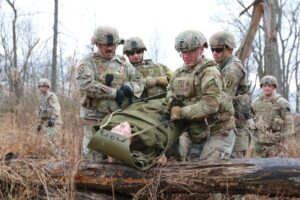
Story by Sgt. 1st Class Shane Smith
166th Regiment – Regional Training Institute
FORT INDIANTOWN GAP, Pa. – Sixteen U.S. Army National Guard Soldiers with the 166th Regiment – Regional Training Institute (RTI) completed a Combat Lifesaver (CLS) course instructed by the RTI’s Medical Battalion Training Site (MBTS) here Dec. 16-20, 2024.
The CLS course is a 40-hour program and covers a wide variety of topics pertaining to medical field care. A CLS-trained Soldier is capable of providing advanced first aid and lifesaving techniques in combat situations.
“In the CLS course we cover everything that happens from the point of injury until a casualty is evacuated and transported to the next level of medical care,” said Sgt. Joshua Nassau, a MBTS Combat Medic Specialist and CLS course instructor.
During the course, students trained on head injuries, hypothermia treatment, pain management and antibiotics, splinting and applying tourniquets to wounds, calling in a 9-line medical evacuation, various patient reports and documentation, and more.
This course was unique in that all instructors and students were 166th Regiment RTI staff members.
“It’s been a great week of comaraderie building,” said Sgt. 1st Class Wellington Brown, a CLS student. “Since we’re all with the RTI, we’re able to bond and develop together while, having a good time while getting some great training.”
But what’s the value in the RTI conducting a CLS course for its own instructors and staff? Nassau provided some insight, saying, “If something happens to one of these instructors’ students in the field, having this training allows them to respond immediately and provide the needed medical care until a medic arrives.”
This makes sense, considering CLS-trained Soldiers are not intended to replace medical personnel outright. But their training can help slow the decline of a wounded Soldier’s condition until medical help arrives, and then a CLS can provide further assistance to that medic and the patient.
“It’s a very hands-on course, which is good for retaining all the knowledge we’ve learned,” said Brown. “I see a lot of value in the course and would recommend it to others.”